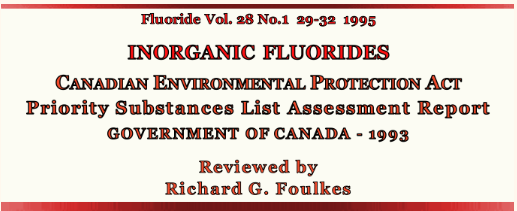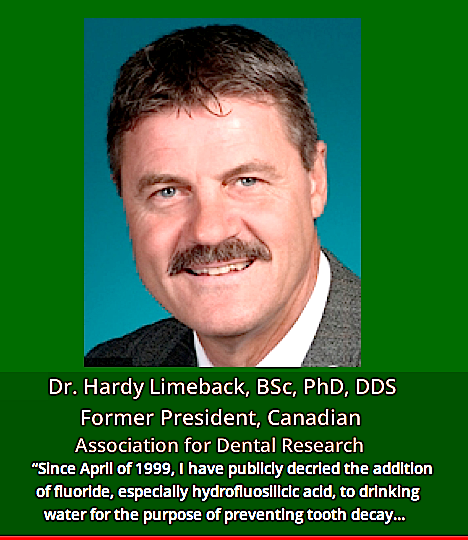27 December | RESEARCH PAPERS A | admin
CANADIAN ENVIRONMENTAL PROTECTION ACT – FLUORIDES.
Total inorganic fluoride emitted to the environment annually in
Canada from anthropogenic sources is estimated to be 23,500 tonnes.
FLUORIDES-CANADIAN ENVIRONMENTAL PROTECTION ACT
SUMMARY OF REPORT
Objectives:
The publication, Inorganic Fluorides
(Priority Substances. List Assessment Report 1993)
Prepared by the Government of Canada pursuant to the Canadian
Environment Protection Act (CEPA) This Act requires the
Federal Ministers of the Environment and of Health
to prepare and publish a Priority Substances
List that identifies substances that may
be harmful to the environment
or constitute a danger
to human health.
“Toxic” is defined in Section 11 of the Act: “…
a substance is toxic if it is entering or may enter the
environment in a quantity or concentration or under conditions:
(a) having or that may have an immediate or long-term harmful effect on the environment;
(b) constituting or that may constitute a danger to the environment on which human life depends; or
(c) constituting or that may constitute a danger in Canada to human life or health.”
The Report states that “the assessment of whether ‘inorganic fluorides’ are `toxic’, was based on the determination of whether they enter or are likely to enter the Canadian environment in a concentration or quantities or under conditions that could lead to exposure of humans or other biota at levels that could cause adverse effects” (emphasis in the original).
Methodology
The Report states that the data used in the study were derived from studies of humans and laboratory animals exposed to different forms of inorganic fluoride compounds. Data regarding human health published after July 1993, and on the environment after April 1993, were not considered for inclusion.
With respect to the effects of fluoride on human health, it is stated: “neither dental fluorosis nor the beneficial effects of fluoride in the prevention of dental caries have been assessed in this report”.
The principal inorganic fluorides assessed were; hydrogen fluoride (HF);
calcium fluoride (CaF2); sodium fluoride (NaF); and sulphur hexafluoride (SF6).
The conclusions were:
a) that inorganic fluorides are entering the environment in quantities or under conditions that may be harmful to the environment;
b) there is insufficient information to conclude whether sulphur hexafluoride is entering the environment in quantities or under conditions that may constitute a danger to the environment on which human life depends (i.e., global climate change); and
c) that inorganic fluorides (i.e., the fluoride ion derived from such inorganic substances) are not entering the environment in quantities or under conditions that may constitute a danger to human life or health.
Discussion
The strong suit in this study is the concise review of the properties, production and uses of inorganic fluorides, and the review of the known effects of anthropogenic sources of fluoride on plants and other biota such as ungulates and aquatic species.
In a section entitled “Ecotoxicity”, the Report discusses a number of key studies, selected on the basis of “proper controls, measured toxicant concentrations, acceptable protocols and identification of the most sensitive biota”.
From these, those responsible for the study deduced that inorganic fluorides are entering the Canadian environment at concentrations that may cause long-term harmful effects to biota in aquatic and terrestrial ecosystems. For example, with regard to the effects on aquatic organisms, the authors extrapolate laboratory findings to the field; to yield estimated adverse effect thresholds (lethal, growth impairment, and decreased egg production) of 0.28 mg/L fluoride for fresh water species and 0.5 mg/L fluoride for marine species. These are exceeded by many anthropogenic sources. With regard to the adverse effects of inorganic fluoride, especially air emissions, the authors review inorganic fluoride toxicity to plants and animals, especially herbivores. The white-tailed deer consuming contaminated browse, was used as a “model”. The authors concluded that inorganic fluorides from anthropogenic sources result in concentrations in some Canadian plants and air that may cause long-term adverse effects to biota in terrestrial ecosystems.
The weakness of this Report that could rob it of total credibility is the obvious protection of the Government-sanctioned process of adding inorganic fluoride to drinking water. In the preceding example of the effects thresholds for aquatic organisms, no mention is made that one of the anthropogenic sources discharging inorganic fluoride into Canadian water that exceed these, is effluent from fluoridated cities that may persist, in fresh water, for some distance.
In fact, the absence of an estimate of inorganic fluoride from this source, in the text and in the accompanying table (Table 1), is conspicuous.
Total inorganic fluoride emitted to the environment annually in Canada from anthropogenic sources is estimated to be 23,500 tonnes. The amount released to the water is estimated to be 13,500 tonnes, 80% of which is attributed to phosphate fertilizer production (11,000 tonnes). The authors give indirect evidence to enable the reader to calculate that approximately 10 million people in Canada are “fluoridated” and that the annual release of inorganic fluoride from this source is approximately 2000 tonnes. This puts this source in second place, behind phosphate fertilizer production, but ahead of chemical production (1362 tonnes ), coal-fired power (555 tonnes), primary aluminium production (307 tonnes), and others that are identified.
In the Recommendations of the Report a request is made for information on the extent of releases from municipal drinking water fluoridation. With the authority of the Government of Canada and two Ministries, it is surprising that this information was not obtained during data collection.
The conclusion that “inorganic fluorides (i.e. fluoride ions) are not entering the environment in quantities or under conditions that may constitute a danger to human life or health” is derived from a somewhat tautological argument.
The Report presents a digest of previously published reviews and secondary sources that deal with the possible adverse effects of inorganic fluoride on human health. Like previous assessments of inorganic fluoride and human health to be found in recent literature, dental fluorosis is not considered an “adverse effect”. In fact, this Report ignores this effect except with regard to its occurrence in herbivores and that it does occur at a lower intake in humans than that required for skeletal changes.
The Report presents (Table 3) an estimated intake of inorganic fluoride by the population of Canada. This table shows intake by various age groups in micrograms per kilogram body weight per day (p.gm/Icg bw/day). It includes breast-fed and formula-fed infants and all age groups exposed to “fluoridated” and “non-fluoridated” water. The table appears to have been prepared largely from studies reported by the Environmental Health Directorate in 1992. The Table is comprehensive in as much as it shows intake form ambient air, food, soil, water (both “fluoridated” and “non-fluoridated”) and household products.
Those responsible for the Report state that “available information is considered inadequate … to assess the carcinogenicity of inorganic fluoride in humans” and recognize that the dose-response trend in the occurrence of osteosarcoma in rat experiments cannot be dismissed. The authors also recognize that there is evidence that fluoride is genotoxic, based on the outcome of in vitro and in vivo studies, and that this may be an effect of fluoride that results from its inhibition of enzymes involved in DNA synthesis and/or repair.
The authors, also, show that they have reservations regarding the potential of adverse effects upon human reproduction, development, or the central nervous and immune systems, at levels required to produce skeletal effects.
Nevertheless, the authors opt to consider that effects on the skeleton are more relevant than others in assessing the toxicological effects of long-term exposure to inorganic fluorides.
The authors present data from a number of studies and conclude that potentially adverse effects associated with skeletal fluorosis are likely to be observed at intakes of greater than approximately 200 ugin/kg bw/day fluoride. Based on the information that estimated daily intakes of inorganic fluoride range from approximately 0.5 to 160 ugm/kg bwIday by various age groups in the population, the authors conclude that these are less than the level at which adverse effects on the skeleton are anticipated.
Conclusion
This assessment document is an interesting addition to the literature on inorganic fluoride. The sections devoted to the ecological effects of emissions in Canada from anthropogenic sources point to serious adverse effects on aquatic and terrestrial biota. These suggest, also, that there is a need for further study of sulphur hexafluoride and its possible role in global climate change.
Overall, the Report suffers from the obvious attempt to defend the current support of fluoridation of drinking water. The deliberate omissions in the study arc evidence of this, in addition to the acceptance, in the section on human health, that the development of crippling skeletal fluorosis is the adverse effect for which a threshold should be determined.
If these omissions had been included in the Report, the quantity and concentration of emissions into the aquatic ecosystem from fluoridated communities would have been shown to exceed the effect thresholds for aquatic life.
In addition, consideration would have been given to the growing view, even of a spokesman from the Canadian Dental Association, that systemic fluoride does not prevent caries, but topical fluoride may have a “remineralization” effect on incipient caries.
Finally, if dental fluorosis, as a clinical entity, had been fully discussed, the Report would have to present the view that it represents a continuum developing in severity along with skeletal changes. If dental fluorosis, in humans, were to be accepted that the intake of inorganic fluoride by children living in fluoridated areas of Canada easily exceeds the effects threshold.
This Report, in spite of some excellent sections on such aspects as ecotoxicity,
lacks credibility as, once again, the politics of fluoridation have
pre-empted objectivity and science.
Reference
1 Canadian Environmental Protection Act., Inorganic Fluorides
(Priority substances list assessment report),
ISBN 0-662-21070-9, Cat. No. En40-215/32E, Minister of Supply and Services Canada, Canada Communication Group Publishing, Ottawa 1993.
Published by:
The International Society for Fluoride Research
Editorial Office: 216 Atkinson Road,
Titirangi, Auckland 7,
New Zealand
The lethal dose of NaF (the artificial fluoride)
is 50 times smaller than that of CaF2
(the naturally-occurring fluoride)
– Dr. Hardy Limeback, Biochemist
and Professor of Dentistry, University of Toronto,
former consultant to the Canadian Dental Association.
“As is normal, the solution to pollution is dilution.
You poison everyone a little bit rather than poison a few people a lot.
This way, people don’t know what’s going on.”



